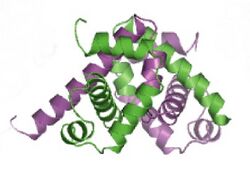Biology:Tryptophan repressor
| Trp repressor protein | |||||||||
|---|---|---|---|---|---|---|---|---|---|
 Ribbon diagram of the trpR protein | |||||||||
| Identifiers | |||||||||
| Symbol | Trp_repressor | ||||||||
| Pfam | PF01371 | ||||||||
| Pfam clan | CL0123 | ||||||||
| InterPro | IPR000831 | ||||||||
| SCOP2 | 2wrp / SCOPe / SUPFAM | ||||||||
| |||||||||
| Trp operon repressor | |||||||
|---|---|---|---|---|---|---|---|
| Identifiers | |||||||
| Organism | |||||||
| Symbol | trpR | ||||||
| Entrez | 948917 | ||||||
| RefSeq (Prot) | NP_418810 | ||||||
| UniProt | P0A881 | ||||||
| Other data | |||||||
| Chromosome | genome: 4.63 - 4.63 Mb | ||||||
| |||||||
Tryptophan repressor (or trp repressor) is a transcription factor involved in controlling amino acid metabolism. It has been best studied in Escherichia coli, where it is a dimeric protein that regulates transcription of the 5 genes in the tryptophan operon.[1] When the amino acid tryptophan is plentiful in the cell, it binds to the protein, which causes a conformational change in the protein.[2] The repressor complex then binds to its operator sequence in the genes it regulates, shutting off the genes.[3][4]
One of the genes regulated by trp repressor, trpR, codes for the tryptophan repressor protein itself. This is a form of feedback regulation. However, these genes are located on different operons.
The (tryptophan) repressor is a 25 kD protein homodimer which regulates transcription of the tryptophan biosynthetic pathway in bacteria. There are 5 operons which are regulated by trpR: the trpEDCBA, trpR, AroH, AroL, and mtr operons.
Mechanism
When the amino acid tryptophan is in plentiful supply in the cell, trpR binds 2 molecules of tryptophan, which alters its structure and dynamics so that it becomes able to bind to operator DNA. When this occurs, transcription of the DNA is prevented, suppressing the products of the gene - proteins which make more tryptophan. When the cellular levels of tryptophan decline, the tryptophan molecules on the repressor fall off, allowing the repressor to return to its inactive form.
trpR also controls the regulation of its own production, through regulation of the trpR gene.[5]
The structure of the ligand-bound holorepressor, and the ligand-free forms have been determined by both X-ray crystallography and NMR.[6][7][8][9][10]
The trp operon consists of a regulatory gene, a promoter, an operator, and a terminator. The trp operon is active only when cellular tryptophan is scarce. If there isn't enough tryptophan, the repressor protein breaks off from the operator (where the repressor is normally bound) and RNA polymerase can complete its reading of the strand of DNA. If the RNA polymerase reaches the terminator (at the end of the DNA strand), the enzymes for tryptophan biosynthesis are expressed.
See also
- trp operon
- Paul Sigler
References
- ↑ "Dynamic regulation of the tryptophan operon: A modeling study and comparison with experimental data". Proc. Natl. Acad. Sci. U.S.A. 98 (4): 1364–9. 2001. doi:10.1073/pnas.98.4.1364. PMID 11171956. Bibcode: 2001PNAS...98.1364S.
- ↑ Zhang RG, Joachimiak A, Lawson CL, Schevitz RW, Otwinowski Z, Sigler PB (1987). "The crystal structure of trp aporepressor at 1.8 A shows how binding tryptophan enhances DNA affinity". Nature 327 (6123): 591–7. doi:10.1038/327591a0. PMID 3600756. Bibcode: 1987Natur.327..591Z.
- ↑ "Studies of the Escherichia coli Trp repressor binding to its five operators and to variant operator sequences". Eur. J. Biochem. 265 (3): 919–28. 1999. doi:10.1046/j.1432-1327.1999.00792.x. PMID 10518785.
- ↑ "The tryptophan repressor sequence is highly conserved among the Enterobacteriaceae". Nucleic Acids Res. 22 (10): 1821–9. 1994. doi:10.1093/nar/22.10.1821. PMID 8208606.
- ↑ "Trp aporepressor production is controlled by autogenous regulation and inefficient translation". Proc. Natl. Acad. Sci. U.S.A. 79 (10): 3120–4. May 1982. doi:10.1073/pnas.79.10.3120. PMID 7048301. Bibcode: 1982PNAS...79.3120K.
- ↑ Schevitz RW, Otwinowski Z, Joachimiak A, Lawson CL, Sigler PB (1985). "The three-dimensional structure of trp repressor". Nature 317 (6040): 782–6. doi:10.1038/317782a0. PMID 3903514. Bibcode: 1985Natur.317..782S.
- ↑ Otwinowski Z; Schevitz RW; Zhang RG et al. (1988). "Crystal structure of trp repressor/operator complex at atomic resolution". Nature 335 (6188): 321–9. doi:10.1038/335321a0. PMID 3419502. Bibcode: 1988Natur.335..321O.
- ↑ "Tandem binding in crystals of a trp repressor/operator half-site complex". Nature 366 (6451): 178–82. 1993. doi:10.1038/366178a0. PMID 8232559. Bibcode: 1993Natur.366..178L.
- ↑ "Refined solution structures of the Escherichia coli trp holo- and aporepressor". J. Mol. Biol. 229 (3): 735–46. 1993. doi:10.1006/jmbi.1993.1076. PMID 8433368.
- ↑ Zhang H; Zhao D; Revington M et al. (1994). "The solution structures of the trp repressor-operator DNA complex". J. Mol. Biol. 238 (4): 592–614. doi:10.1006/jmbi.1994.1317. PMID 8176748.
 |

